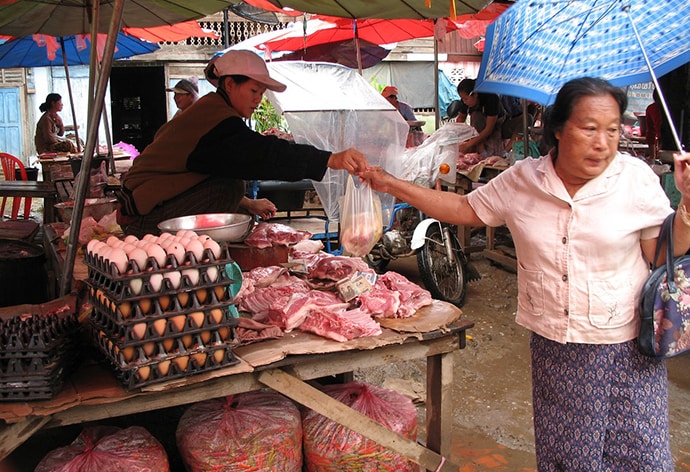Wild meat may be a crucial source of protein for some people or a special treat for others, but handling and eating it comes with a substantial risk of exposure to pathogens that can jump from animals to humans.
So concludes a recent paper in Emerging Infectious Disease that documents zoonotic pathogens in animals from wildlife trade sites in Laos. Some animals were confiscated by the Provincial Offices of Forest Inspection (POFI), and others were from market stalls or trade hotspots. Most of the animals were from the squirrel family or civet. Bats were not commonly found.

Of the trade animals, 26% carried pathogens. In comparison, 71% of samples from POFI had pathogenic bacteria. Market samples were collected from 14 sites by a local team from the Wildlife Conservation Society. After getting permission from vendors, the team collected urogenital swabs, urine and blood samples, and tissue from the spleen, liver, and kidney of more than 37 species, mostly different types of squirrels.
Author Matthew T. Robinson, PhD, is head of molecular bacteriology at LOMWRU, the Lao-Oxford-Mahosot Hospital-Wellcome Trust Research Unit, Vientiane, Laos. He told Medscape Medical News that in this study, the investigators did PCR tests looking for Leptospira, Rickettsia, Orientia tsutsugamushi, Anaplasma, Ehrlichia chaffeensis, Coxiella burnetti, flaviviruses, hantavirus, dengue virus, Zika virus, and universal bacterial 16S rRNA.
They did not look for other viral pathogens. The organisms selected came from a “target list created by our collaborators through discussions — our collaborators at WCS Wildlife Conservation Society and Institut Pasteur Cambodia,” Robinson said.
Of 324 animals tested at trade sites, 65 (20.1%; 95% CI, 15.9% – 24.9%) were positive for Leptospira spp., and 69 (21.3%; 95% CI, 17.0% – 26.2%) were positive for more than one pathogen. Of the 35 animals collected by POFI, a greater proportion were positive for more than one pathogen, including Rickettsia, Anaplasma, and others. Rickettsia spp. were detected exclusively in solid organs (liver, kidney, and spleen).
Leptospira were the most common pathogens, noted in 74 of 359 total tested animals. “It’s one of the key pathogens that cause nonmalarial fevers,” Robinson said.
Urogenital specimens were most likely to be positive, highlighting the risk for transmission of leptospirosis through infected urine. One puzzle was that there was a higher risk for Leptospira detection in the wild meat tested in the dry season. Yet, leptospirosis is more commonly associated with heavy rains and flooding. He wondered if there was an as yet undetected reservoir for these bacteria.
In contrast, Rickettsia were found in the solid organs, primarily the liver and spleen.
The researchers did not explicitly look for Campylobacter, Salmonella, E. coli, or similar common foodborne pathogens. Robinson noted they were not picked up by the universal 16S rRNA gene PCR, which has a high concordance (> 90%) with routine bacterial culture.
Robinson is hopeful the research will help improve health standards in the markets overall.
He said the consumers’ perception is changing because “it’s becoming more urbanized, the wildlife meat. While they do have access to things like farmed meat, they also opt in to have wildlife meat as an additional food source, as a sort of a treat, or for a special meal. Yes, it’s changing those actual perceptions.”
While many of us have the luxury of choosing our food sources, Robinson stressed that “wildlife meat is a source of protein for certain communities. It may be some communities’ only source of protein, so by banning wildlife meat outright, we’re actually preventing those people from having a suitable food source. So it’s a fine balance.”
He noted, too, that “venison and gamebirds, are all commonly consumed” in Western countries. “But there are regulations for those.” He suggested, “we actually ensure there are regulations to stop and try and prevent contaminated or infectious wildlife from coming into the market.”
Eric Fevre, PhD, is chair of veterinary infectious diseases, Institute of Infection and Global Health, University of Liverpool, Liverpool, England. In an email interview, he echoed Robinson, saying, “The paper shows the consistent hazard posed by the preparation and consumption of wild-sourced animal products, and highlights the value of long-term surveillance in monitoring those hazards in real-world settings, and the quantification of the risk to humans involved in handling these kinds of products. Investment in surveillance is of key importance.”
Robinson said, “While surveillance is very much looking for a needle in the haystack…it is important as other work.” He concluded the interview by saying, “The key point is that the consumption of wildlife means it is important to some communities, and that we need better surveillance and better monitoring.”
Robinson and Fevre have disclosed no relevant financial relationships.
Emerg Infect Dis. 2022;28:860-864. Full text
Judy Stone, MD, is an infectious disease specialist and author of Resilience: One Family’s Story of Hope and Triumph Over Evil and of Conducting Clinical Research, the essential guide to the topic. You can find her at drjudystone.com or on Twitter @drjudystone.
For more news, follow Medscape on Facebook, Twitter, Instagram, and YouTube.
Source: Read Full Article
